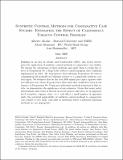Synthetic Control Methods for Comparative Case Studies: Estimating the Effect of California's Tobacco Control Program
Author(s)
Abadie, Alberto; Diamond, Alexis; Hainmueller, Jens
DownloadHainmueller_Synthetic Control.pdf (247.1Kb)
OPEN_ACCESS_POLICY
Open Access Policy
Creative Commons Attribution-Noncommercial-Share Alike
Terms of use
Metadata
Show full item recordAbstract
Building on an idea in Abadie and Gardeazabal (2003), this article investi-
gates the application of synthetic control methods to comparative case studies.
We discuss the advantages of these methods and apply them to study the ef-
fects of Proposition 99, a large-scale tobacco control program that California
implemented in 1988. We demonstrate that following Proposition 99 tobacco
consumption fell markedly in California relative to a comparable synthetic con-
trol region. We estimate that by the year 2000 annual per capita cigarette sales
in California were about 26 packs lower than what they would have been in the
absence of Proposition 99. Using new inferential methods proposed in this ar-
ticle, we demonstrate the signi¯cance of our estimates. Given that many policy
interventions and events of interest in social sciences take place at an aggregate
level (countries, regions, cities, etc.) and affect a small number of aggregate
units, the potential applicability of synthetic control methods to comparative
case studies is very large, especially in situations where traditional regression
methods are not appropriate.
Date issued
2010-06Department
Massachusetts Institute of Technology. Department of Political ScienceJournal
Journal of the American Statistical Association
Publisher
American Statistical Association
Citation
Alberto Abadie, Alexis Diamond, Jens Hainmueller. Journal of the American Statistical Association. June 1, 2010, 105(490): 493-505. doi:10.1198/jasa.2009.ap08746.
Version: Author's final manuscript
ISSN
0162-1459
1537-274X